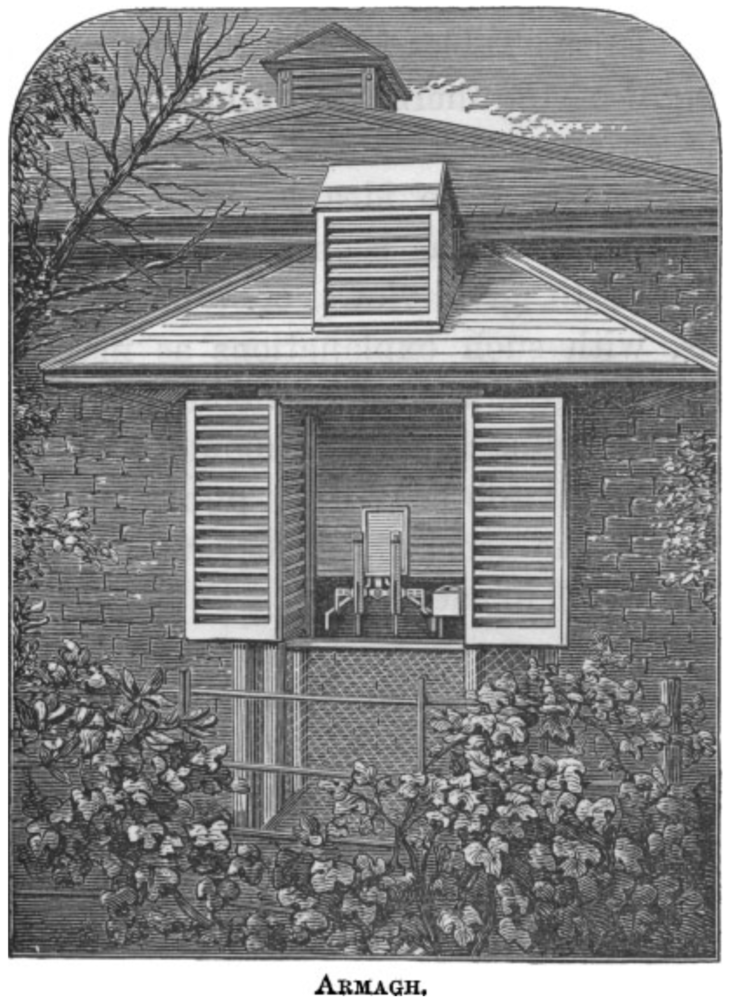Meteorological measurements were started at Armagh Observatory in December 1794, with daily measurements beginning in 1795. They have continued uninterrupted ever since. They represent the longest series of continuous weather records in Ireland, and perhaps the longest in the entire British Isles – the latter is subject to some debate. This is an invaluable resource for climate scientists and historians.
Temperature and pressure were recorded from the start, rainfall has been continuously recorded here since 1836, wet bulb temperatures from 1838, the wind since 1843, and the daily maximum and minimum temperatures from 1844. A Stevenson Screen was installed in 1865, providing a controlled environment for temperature measurements from this date onwards.
Today, manual measurements are still taken at 9am GMT every single day, an unbroken record stretching back to 14 July, 1795. Multiple automatic weather stations have been installed, the first in 1866. Support from the Northern Ireland Department for Communities allowed the latest automatic weather station to be installed by Met Office engineers in 2018, supplementing the daily manual measurements with continuous observations.

A scan of the first weather readings – temperature and pressure – taken at Armagh Observatory from December 1794 onwards. An unbroken record began in July 1795.

Graph illustrating the length of the Armagh climate series for various meteorological parameters

19th Century Innovations
Multiple new meteorological instruments were developed in the 19th century. A sunshine recorder was invented by John Francis Campbell – a Scottish author and scholar – in 1853 and modified in 1879 by Sir George Gabriel Stokes, the famous Irish physicist and mathematician. He was a good friend of the third Director of Armagh Observatory, Thomas Romney Robinson – indeed, Stokes’ wife was Mary Susanna Robinson, the Director’s daughter. It is therefore no surprise that we have been using the sunshine recorder since 1880, immediately after Stokes made his modified design – used worldwide to this day.
The study of meteorology at large was in fact one of Director Robinson’s most enduring interests, aside from his astronomy work. He was particularly interested in the measurement of wind speed. He invented the cup anemometer – a device that has been widely used throughout the world ever since. It is reported that the design was originally suggested to him by Richard Lovell Edgeworth.

Automated Weather Stations
When the Board of Trade decided to establish seven automatically-recording weather stations around the British Isles in 1867, it was – due to Robinson’s enduring interest in the field as well as his valuable contributions to it – natural that Armagh was chosen as one of the sites. Every hour for 50 years the wind direction and speed were recorded at the newly-constructed Meteorological Building next to the Observatory (roughly in place of the Library today). Though this large body of data has never been properly analysed, it remains one of the earliest complete wind surveys undertaken. Temperature (dry and wet), barometric pressure, vapour tension (vapour pressure), and hourly rainfall were also recorded automatically.
For a brief discussion of these Automatic Weather Stations, see:
III. Report of the meteorological committee to the President and Council of the Royal Society on the work done in the Meteorological Office since their appointment in 1866 to December 31, 1875 (available on the Royal Society pages here); “III. Land Meteorology of the British Isles” (pp.204–208)
Multiple automatic weather stations have been commissioned since, including one from 2001 to 2006 and another from 2006 to 2012. The latest such weather station has been installed within the Met Enclosure in 2018 and conforms to the Met Office standards. With its array of digital instruments, it is making continuous observations of wind, temperature, pressure and more.









